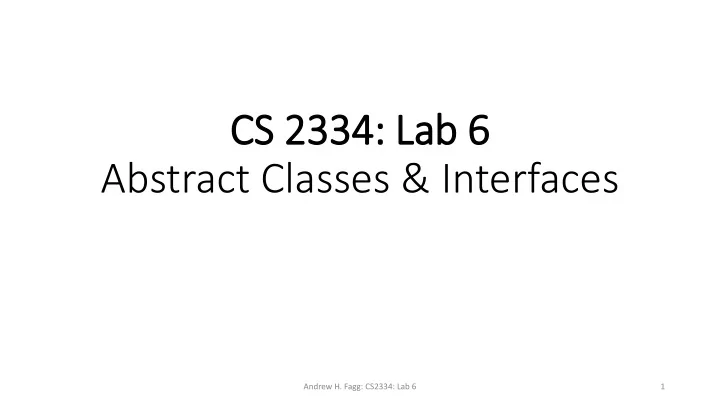

CS 2334: Lab 6 Abstract Classes & Interfaces Andrew H. Fagg: CS2334: Lab 6 1
Abstract Class Few important points to remember about abstract classes: • An abstract class is a class that is declared ‘ abstract ’ • It can, but does not have to, include abstract methods • Abstract classes can not be instantiated but they can be subclassed using the extends keyword • An abstract method is a method that is declared without an implementation • Requires the abstract keyword Andrew H. Fagg: CS2334: Lab 6 2
Abstract Class • If a class includes abstract methods, then the class itself must be declared as abstract. //declaring class abstract public abstract class Person{ //declaring method abstract abstract void generateID( ); } • When a child class extends an abstract class, it must either: • Provide implementations for all abstract methods from its parent class, or • Also be abstract • Child classes can reference the constructor of abstract class by using super() Andrew H. Fagg: CS2334: Lab 6 3
In Interface • Interface is a blueprint of a class. • It has static constants and abstract method only • It can not be instantiated • Interface represents is-a relationship interface printable{ void print(); } class print implements printable{ public void print(){System.out.println(“Hello”);} } Andrew H. Fagg: CS2334: Lab 6 4
What is the Difference between Abstract Classes and In Interfaces? Andrew H. Fagg: CS2334: Lab 4 5
Abstract Classes vs In Interfaces • Abstract class can have abstract and non-abstract methods while interface can only have abstract methods • Class inheritance (extension) does not support multiple inheritance, while a class can implement an arbitrary number of interfaces • Abstract classes can have final, non-final, static or non-static variables while interface can have only final and static variables Andrew H. Fagg: CS2334: Lab 4 6
Lab 6: : Representing Shapes Given a UML diagram that describes the relationships between shape classes: • Implement each class, including the specified instance variables and methods • Implement testing procedures for the classes Andrew H. Fagg: CS2334: Lab 6 7
Representing Different Geometrical Shapes Interfaces from the Java API: • Comparable • Comparator Andrew H. Fagg: CS2334: Lab 6 8
Lab 6 Preparation • Download lab6-initial.zip • Import into your Eclipse environment (details of how to do this are in the lab specification) Andrew H. Fagg: CS2334: Lab 6 9
Lab 6 Notes • Create each class in the UML diagram • Include all methods and instance variables, with the specified visibility • Watch spelling and casing • Use the default package • Implement attributes and methods • Classes are dependent on each other, so you can have temporary errors while you implement • Expand on the given test class to make sure it all works Andrew H. Fagg: CS2334: Lab 6 10
Submission • Submit only one file: lab6.zip (casing matters) • Due date: Friday, October 2 nd @11:59pm • Submit to lab6 dropbox on D2L Andrew H. Fagg: CS2334: Lab 6 11
Recommend
More recommend